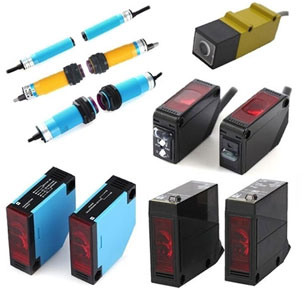How to Detect Photoelectric Sensor?
The detection modes of photoelectric sensor are divided into the following categories: opposite type, reflective plate type, polarizing reflective plate type, direct opposite type, wide beam type, focused mode, fixed-field type and adjustable-field type. Ultrasonic sensor includes two detection mode of opposite type and proximity.
Opposite type
Transmitter and receiver of the opposite detection mode are installed in an opposite mode, the light from the transmitter aims at the receiver directly. When the object blocks the beam, output of the sensor changes to indicate that the detected object is detected.
Reflective plate type
In the reflective plate detection mode, a sensor has both transmitter and receiver. The light emitted from the transmitter shines upon the reflective plate, the reflected light returns to the receiver. When the object blocks the beam, the detected object is detected.
Proximity detection
In the proximity detection mode, both photoelectric and ultrasonic sensors determine whether or not an object is detected by measuring the energy reflected from the object. For example, when the ultrasonic sensor receives the sound reflected from the object, the detected object is detected. The transmitter and receiver of the sensor are assembled together on the same side.
Direct opposite type
Direct trans sensor is a commonly used detection mode among the photoelectric sensors. In this mode, the light emitted from the transmitter is illuminated to the surface of the object at various angles, and the surface of the object reflects the light from various angles similarly, and only a small part of light are reflected back to the receiver.
Focused mode
A detection mode that can detect small objects is called the focused mode. Most focus sensors add a lens to the transmitter, so as to ensure the emitted light is focused at a point in front of the lens. Meanwhile, the focus of receiver focus is also here. Thus a small detection area of energy concentration is formed at a fixed distance.
Fixed-field type
Fixed-field sensor is a kind of photoelectric proximity sensor. It has a clear detection range and can ignore objects outside this range without being affected by the surface reflectivity of the object.
Adjustable-field type
Like the fixed-field type, the adjustable-field sensor can distinguish objects at different distances. In this case, the detection distance is adjustable. The receiver of adjustable-field sensor can produce two current of I1 and I2, whose ratio varies with the location of the reflected light on the receiver. The location of the sensor's cut-off point is directly related to this ratio, and the position of the cut-off point can be adjusted by potentiometer, even if the objects outside of the cut-off point have strong reflectors, the sensor still ignores them.
Optical fiber type
Actually, optical fiber is not a specific detection mode, different optical fibers can form different detection modes. Separating optical fiber can be used to form the opposite detection mode, the integrated optical fiber can form the reflective plate or proximity detection mode. Special fiber can be customized. Special structures have been used on the detection end of the optical fiber, which forms the focus detection lens.
Ultrasonic proximity mode
After the AC voltage is supplied, the ultrasonic generator vibrates. This vibration alternately compresses and strikes air molecules to transmit ultrasonic waves continuously. Meanwhile, the ultrasonic generator can also receive the echo of the ultrasonic wave.

